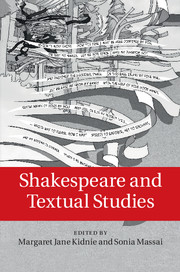Book contents
- Shakespeare and Textual Studies
- Shakespeare and Textual Studies
- Copyright page
- Contents
- Figures
- Tables
- Contributors
- Book part
- Introduction
- Part I Scripts and manuscripts
- Part II Making books; building reputations
- Part III From print to manuscript
- Part IV Editorial legacies
- Part V Editorial practices
- Part VI Apparatus and the fashioning of knowledge
- Works cited
- Index
- References
Works cited
Published online by Cambridge University Press: 05 November 2015
- Shakespeare and Textual Studies
- Shakespeare and Textual Studies
- Copyright page
- Contents
- Figures
- Tables
- Contributors
- Book part
- Introduction
- Part I Scripts and manuscripts
- Part II Making books; building reputations
- Part III From print to manuscript
- Part IV Editorial legacies
- Part V Editorial practices
- Part VI Apparatus and the fashioning of knowledge
- Works cited
- Index
- References
- Type
- Chapter
- Information
- Shakespeare and Textual Studies , pp. 415 - 451Publisher: Cambridge University PressPrint publication year: 2015

